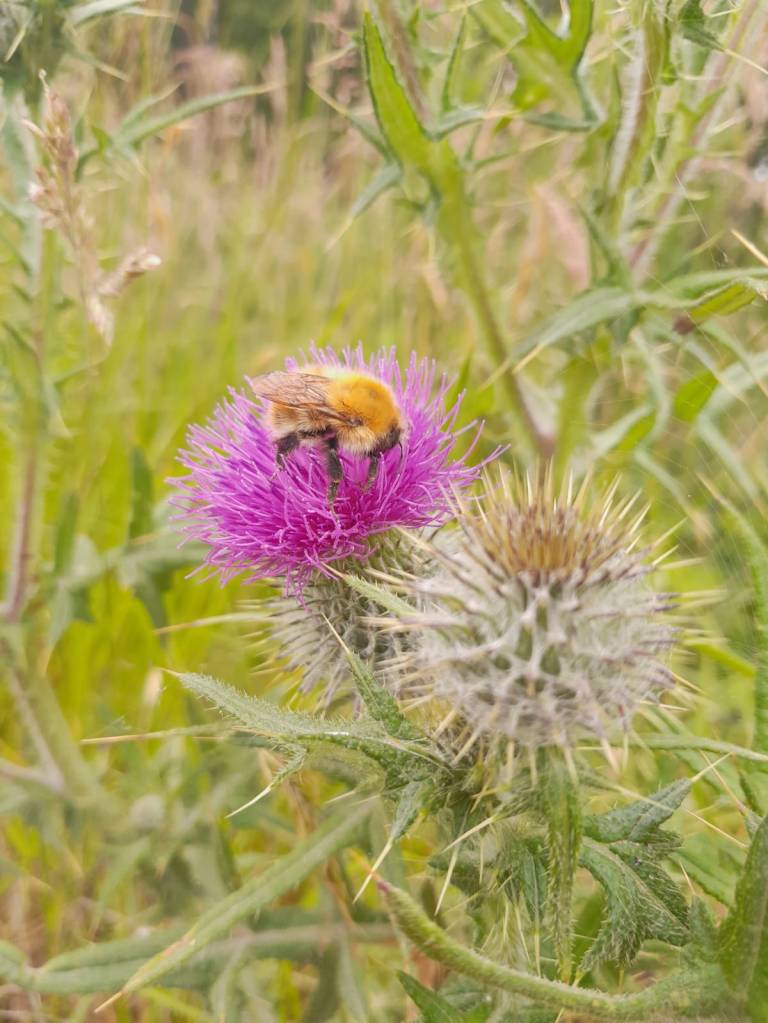Flanders NNR
O’ flower of Scotland, when will we see our meadow again?
Summer is well and truly here at Flanders Moss with many warm weather species beginning to flourish. There are some species however, that may be flourishing a little too much. The past week at Flanders the team have been hard at work giving some TLC to the moss and managing the vegetation that has had some growth spurts over the past weeks. The wildflower meadow by the car park has recently become dominated by Creeping Thistles. These plants can easily overrun an area and displace native plants. Unlike the native thistles, these plants are spiny the full length of the stem and therefore have to be pulled from as close to the root as possible not only for safety but also for the best chances that they do not regenerate.


Any regular Flanders visitor with a keen eye may have noticed a bit of a difference between each side of the wildflower meadow separated by the main pathway. For some reason we have yet to discover, Creeping thistle have dominated one side yet haven’t taken as strong a hold on the other. This has left room for some native thistles to grow.

Moving beyond the wildflower meadow, the pathway through the woodland and approaching the boardwalk was also becoming overgrown with vegetation, including birch and willow saplings. Tree species such as these need to be managed on habitats like Flanders as they require a lot of moisture which we are trying to keep in the bog. Keeping back the tree growth to a manageable rate is therefore an around the clock job. This time around we had our handy mower to speed up the process.

Speaking of moisture on the bog, that was another task in need of doing this past week. Flanders Moss is scattered with walrags (water-level range gauges). These monitoring units help us to collect data about the water moisture content on the bog across its multiple peat domes. There are over 20 walrags spread across the moss so this was going to be a team effort. We split up into pairs and each set out to cover an area of the bog. Water moisture levels are recorded for the current and period max and mins, which is indicated by how far the foam pieces have been pushed apart as the water levels rise and fall. The foam pieces are then moved back together to ‘reset’ the walrags for the next period.


Monitoring the water moisture of the bog is a crucial task for any bog management plan but getting out to each walrag gave us much more information about the condition of the site than just the water moisture levels. Venturing off of the boardwalk and out onto the bog we found many indicators of how the site is recovering. The presence of some species was a very exciting distraction from the heat we all endured as we squelched our way from walrag to walrag.


Each pair found different species across the bog. Student placement officer Ellie is pictured above with a Black Arches moth and reserve officers Robyn and Steve spotted a curlew that could be nesting on the bog. For our seasonal officers Robyn and Emma it was one of the first opportunities to explore areas of the bog we had never seen before. We were in awe of the vibrancy of the moss turning from reds to greens and back again as we walked, with blankets of cranberries covering some patches, they seem to have had a productive year on the bog. A not so welcome species we stumbled upon were some rouge Sitka Spruce saplings which Ellie saw to on passing.
Despite the bog appearing rather dry, likely from the multiple days of heat and no rain in the lead up to our venture, we did see some exciting evidence of recovery in areas of the bog with exposed peat. In some of these patches we found that vegetation was beginning to reclaim the soil with White beak-sedge sprouting all around. This small white flower thrives in wet, acidic conditions and is thus a great indicator of bog ecosystem health.




Management of birch growth across the moss will continue in coming months with some volunteer events planned to help tackle the spread. For now the team are pleased with a successful day of walrag monitoring and the sighting of indicative species have left us feeling positive about the recovery of the moss in some areas that had been previously exposed. The final success of the day however, everyone returning to the vans dry! Until we next leave the boardwalk…
A very interesting account to read.
LikeLike